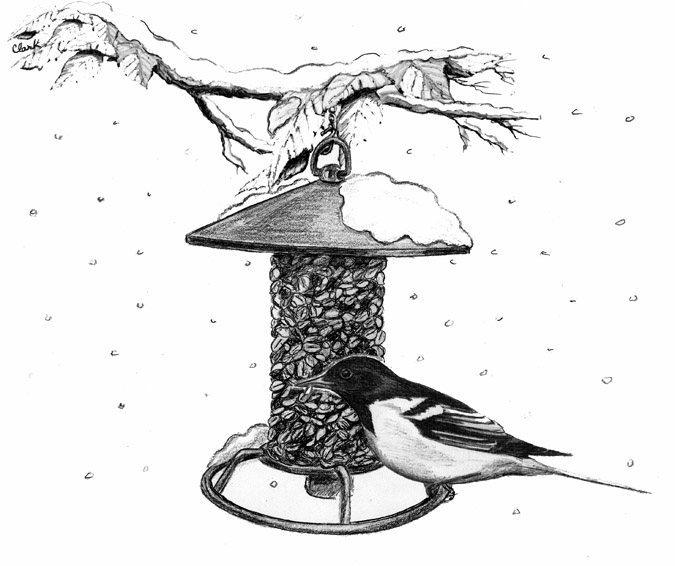
Dear Bird Folks,
I looked out at my feeder this morning and was surprised to see a Baltimore Oriole feeding with all of the other birds. I usually don’t get orioles until May. Why are they back so early?
– Don, Brewster, MA
I wish, Don,
I wish the orioles were back early. Their arrival would mean customers would start buying oriole feeders once again. Since last summer those feeders have been sitting on the shelf, gathering dust and feeling lonely and ignored; banished to the feeder version of the Island of Misfit Toys. Unfortunately, those feeders are going to have to wait a little longer before they get dusted off, because the oriole in your yard didn’t come back early…it never left. Normally, Baltimore Orioles, the birds that brighten up our yards each summer, have left this area by the end of October. New England winters might be okay for coffee shops and snowboarders, but they aren’t so great for tropical birds. This is why 99.9999% of “our” orioles spend the winter in Florida, Central America and now, thanks to the embargo being lifted, Cuba. However, each year a few shortsighted orioles don’t make the long journey south. Instead of migrating they try to ride out the winter with the rest of us. This is a bad decision.
Like you, I too have been seeing orioles in my yard this winter. Back on Christmas morning there were four of them drinking out of my heated birdbath. Ordinarily I’d be thrilled to see orioles, but not this time of year. I just knew things weren’t going to end well. On New Year’s Day the birds returned again, but this time the four orioles had become three and on Martin Luther King Jr. Day only two were seen. Then the February snowstorms and deep freeze hit and by Valentine’s Day (apparently, I only notice birds on holidays) only one lone male oriole was still coming to my feeder, and he looked awful. As the snow swirled around, this poor oriole was barely moving. His eyes were scarcely open and his feathers were all disheveled. He looked like someone with a hangover who had just spent the night on a park bench (and I think we all know what that’s like). Meanwhile, the chickadees, finches, and other birds that are used to Cape Cod winters, zipped in and out of the feeders, seemingly oblivious to the subzero weather.
I thought for sure that bedraggled oriole wasn’t going to make it through the night, but then he caught a break. When I went to bed the outside temperature was -3°, but by the time I woke up it had warmed to a balmy 44° and the improving temperatures gave Mr. Oriole a second chance at life. For the next few days he clung to a nut log,* where he ate constantly, slowly regaining his energy. (*The nut log is made of compressed peanuts, sunflower seeds, and raisins, and looks like a meatloaf for vegetarians.)
Now that the temperature was above freezing, I felt it would be a good time to put out a dish of the oriole’s favorite summer food, grape jelly. The instant the bird saw the jelly his eyes grew wide and he flew right over to it. He quickly claimed the jelly for his own and attacked any bird that came close. Even the much larger Blue Jays had to back off. And now that the weather is starting to moderate, I have a feeling this young male might actually make it to spring after all. Yay! Aren’t happy endings the best?
Right now some folks are probably wondering: Why didn’t this bird migrate south with the other orioles when it had the chance? That’s a good question and it’s too bad I don’t know the answer. One possibility is that the bird’s normal migration was delayed for some reason (illness, injury, bridge traffic, etc.), and once the bird missed its migration window he lost his urge to leave. Consequently, he just stayed put and hoped for the best. Another theory is that sometimes birds simply migrate in the wrong direction. Somehow their internal compass gets messed up and instead of flying south or west, they fly east or north, and in this case, mine only stopped because he reached the Atlantic Ocean. To make things even worse, evidence suggests that once a bird migrates in an incorrect direction, it will continue to return to the same “wrong” location year after year for the rest of its life. (And I thought I was stubborn when I got lost.)
It appears this winter has been a banner year for Baltimore Orioles on Cape Cod. Besides you and me, I know of at least six or seven other people who have also been getting orioles on their feeders. Seeing orioles early in the winter is not that strange, but seeing this many in March is rare indeed. Most of the time the birds would have succumbed to the weather by now, but fortunately for them (and us) this winter has been relatively mild. These lost birds are lucky they didn’t arrive here last year, during the apocalyptic winter of 2015. If they had, they most certainly would not have survived for very long. (Heck, I almost didn’t make it through that winter.)
Your oriole may be alone right now, Don, but come May 1st many of its colorful cousins will be returning from the south, tanned, rested and ready to breed. So start looking for your oriole feeders now. Better yet, go out and buy a whole bunch of new ones. It‘s not that I need to increase my feeder sales…I just don’t like dusting.